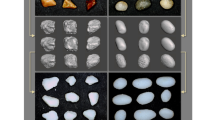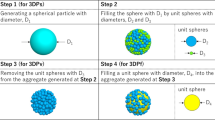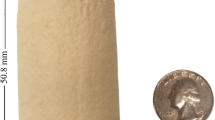Abstract
The influence of surface topography on the mechanical behavior of soil-structure interfaces over a range of particle sizes and shapes is systematically investigated in this research. 3D printed interfaces with different topographies and uniformly graded 3D printed soil particles and two types of natural sands (Ottawa sand 20/30 and Dolomite sand #1, #2 and #3) were employed and tested. Laboratory investigations showed that the shear strength and volume change responses of the 3D printed interfaces are positively influenced with the increase of the inclination of asperities. The proposed wedge friction model successfully explained the distinct mechanical behaviors of soil-structure interfaces under shearing. A “turning point” was found for the interface shear resistance with the increase of the inclination of asperities. When the surface topography produces passive resistance to the soil, the change of the surface topography has little effect on the interface mechanical behavior. The findings from this research will provide insights for soil-structure interface design and discrete element method (DEM) simulations in considering the mechanical behavior of soil-structure interfaces.
Similar content being viewed by others
Abbreviations
- D 50 :
-
Mean particle size
- dh :
-
Increment of horizontal displacement
- D r :
-
Initial relative density
- dv :
-
Increment of vertical displacement
- F :
-
Normal load
- P :
-
Passive resistance
- Q :
-
Horizontal force
- R cr :
-
Critical relative roughness
- R max :
-
Maximum height of asperity
- R n :
-
Relative roughness
- S h :
-
Particle shape parameter
- δ :
-
Mohr-Coulomb interface friction angle
- δ d :
-
Mobilized interface friction angle
- δ if :
-
‘Isolated’ interface friction angle
- δ p :
-
Peak interface friction angle
- δ sf :
-
Angle of sliding friction
- θ :
-
Dip angle of asperity
- κ :
-
Interface shape factor
- μ :
-
Friction coefficient
- ξ :
-
Interface dilation angle
- σ :
-
Normal stress
- ς :
-
Dilatancy coefficient
- τ :
-
Shear stress
- τ max :
-
Peak shear stress
- τsf :
-
Shear stress of sliding friction
- φ :
-
Internal friction angle
- ψ :
-
Internal dilation angle
References
Adamidis O, Alber S, Anastasopoulos I (2020) Assessment of three-dimensional printing of granular media for geotechnical applications. Geotechnical Testing Journal 43(3):20180259, DOI: https://doi.org/10.1520/GTJ20180259
Afzali-Nejad A, Lashkari A, Shourijeh PT (2017) Influence of particle shape on the shear strength and dilation of sand-woven geotextile interfaces. Geotextiles and Geomembranes 45(1):54–66, DOI: https://doi.org/10.1016/j.geotexmem.2016.07.005
ASTM D2487 (2017) Standard practice for classification of soils for engineering purposes (unified soil classification system). ASTM D2487, ASTM International, West Conshohocken, PA, USA
Bhushan B, Nosonovsky M (2004) Comprehensive model for scale effects in friction due to adhesion and two- and three-body deformation (plowing). Acta Materialia 52:2461–2474, DOI: https://doi.org/10.1016/j.actamat.2004.01.038
Bolton MD (1987) Discussion: The strength and dilatancy of sands. Géotechnique 37(2):219–226, DOI: https://doi.org/10.1680/geot.1987.37.2.219
Cho GC, Dodds J, Santamarina JC (2006) Particle shape effects on packing density, stiffness, and strength: Natural and crushed sands. Journal of Geotechnical and Geoenvironmental Engineering 132(5): 591–602, DOI: https://doi.org/10.1061/(ASCE)1090-0241(2006)132:5(591)
Dai BB, Yang J, Zhou CY (2016) Observed effects of interparticle friction and particle size on shear behavior of granular materials. International Journal of Geomechanics 16(1):04015011, DOI: https://doi.org/10.1061/(ASCE)GM.1943-5622.0000520
DeJong JT, Burrall M, Wilson DW, Frost JD (2017) A bio-inspired perspective for geotechnical engineering innovation. Geotechnical Frontiers 2017 No. 862–870, American Society of Civil Engineers, Reston, VA, USA
Dietz MS, Lings ML (2006) Postpeak strength of interfaces in a stress-dilatancy framework. Journal of Geotechnical and Geoenvironmental Engineering 132(11):1474–1484, DOI: https://doi.org/10.1061/(ASCE)1090-0241(2006)132:11(1474)
Dove JE, Jarrett JB (2002) Behavior of dilative sand interfaces in a geotribology framework. Journal of Geotechnical and Geoenvironmental Engineering 128(1):25–37, DOI: https://doi.org/10.1061/(ASCE)1090-0241(2002)128:1(25)
Farhadi B, Lashkari A (2017) Influence of soil inherent anisotropy on behavior of crushed sand-steel interfaces. Soils and Foundations 57(1):111–125, DOI: https://doi.org/10.1016/j.sandf.2017.01.008
Frost JD, DeJong JT (2005) In situ assessment of role of surface roughness on interface response. Journal of Geotechnical and Geoenvironmental Engineering 131(4):498–511, DOI: https://doi.org/10.1061/(ASCE)1090-0241(2005)131:4(498)
Hanaor DAH, Gan Y, Revay M, Airey DW, Einav I (2016) 3D printable geomaterials. Géotechnique 66(4):323–332, DOI: https://doi.org/10.1680/jgeot.15.P.034
Horng JH, Wei CC, Tsai HJ, Shiu BC (2009) A study of surface friction and particle friction between rough surfaces. Wear 267:1257–1263, DOI: https://doi.org/10.1016/j.wear.2009.02.017
Hryciw RD, Irsyam M (1993) Behavior of sand particles around rigid ribbed inclusions during shear. Soils and Foundations 33(3):1–13, DOI: https://doi.org/10.3208/sandf1972.33.3_1
Hu L, Pu J (2004) Testing and modeling of soil-structure interface. Journal of Geotechnical and Geoenvironmental Engineering 130(8): 851–860, DOI: https://doi.org/10.1061/(ASCE)1090-0241(2004)130:8(851)
Jardine RJ, Lehane BM, Everton SJ (1993) Friction coefficients for piles in sands and silts. Springer, Berlin, Germany, 661–677
Jing XY, Zhou WH, Li Y (2017) Interface direct shearing behavior between soil and saw-tooth surfaces by DEM simulation. Procedia Engineering 175:36–42, DOI: https://doi.org/10.1016/j.proeng.2017.01.011
Kang X, Cambio D, Ge L (2012) Effect of parallel gradations on crushed-rock concrete interface behaviors. Journal of Testing and Evaluation 40(1):1–8, DOI: https://doi.org/10.1520/JTE103773
Kang X, Ge L, Chang KT, Kwok AO (2016) Strain-controlled cyclic simple shear tests on sand with radial strain measurements. Journal of Materials in Civil Engineering 28(4):0405169, DOI: https://doi.org/10.1061/(ASCE)MT.1943-5533.0001458
Kang X, Kang GC (2015) Modified monotonic simple shear tests on silica sand. Marine Georesources and Geotechnology 33(2):122–126, DOI: https://doi.org/10.1080/1064119x.2013.805289
Komvopoulos K, Saka N, Suh NP (1986) Plowing friction in dry and lubricated metal sliding. Journal of Tribology 108:301–312, DOI: https://doi.org/10.1115/1.3261181
Lee SJ, Lee CH, Shin M, Bhattacharya S, Su YF (2019) Influence of coarse aggregate angularity on the mechanical performance of cement-based materials. Construction and Building Materials 204:184–192, DOI: https://doi.org/10.1016/j.conbuildmat.2019.01.135
Lings ML, Dietz MS (2005) The peak strength of sand-steel interfaces and the role of dilation. Soils and Foundations 45(6):1–14, DOI: https://doi.org/10.3208/sandf.45.1
Liu CN, Ho YH, Huang JW (2009) Large scale direct shear tests of soil/PET-yarn geogrid interfaces. Geotextiles and Geomambranes 27:19–30, DOI: https://doi.org/10.1016/j.geotexmem.2008.03.002
Martinez A, Frost JD (2017) The influence of surface roughness form on the strength of sand-structure interfaces. Géotechnique Letters 7(1):1–8, DOI: https://doi.org/10.1680/jgele.16.00169
Martinez A, Palumbo S (2018) Anisotropic shear behavior of soil-structure interfaces: Bio-inspiration from snake skin. IFCEE 2018 No. 94–104, American Society of Civil Engineers, Reston, VA, USA
Michalowski RL, Čermák J (2002) Strength anisotropy of fiber-reinforced sand. Computers and Geotechnics 29:279–299, DOI: https://doi.org/10.1016/S0266-352X(01)00032-5
Milligan GWE, Tei K (1998) The pull-out resistance of model soil nails. Soils and Foundations 38(2):179–190, DOI: https://doi.org/10.3208/sandf.38.2_179
Mitchell JK, Villet WCB (1987) Reinforcement of earth slopes and embankment. National Cooperative Highway Research Program Report No.290, Washington DC, USA
Olson RE, Lai JR (1989) Direct shear testing. Advanced Geotechnical Laboratory, Dept. of Construction Engineering, Chaoyang University of Technology, Taichung, Taiwan, ROC
Portelinha FHM, Zornberg JG, Pimentel V (2014) Field performance of retaining walls reinforced with woven and nonwoven geotextiles. Geosynthetics International 21(4):270–284, DOI: https://doi.org/10.1680/gein.14.00014
Rourke BTDO, Druschel SJ, Netravali AN (1990) Shear strength characteristics of sand-polymer interfaces. Journal of Geotechnical Engineering 116(3)451–469, DOI: https://doi.org/10.1061/(ASCE)0733-9410(1990)116:3(451)
Rowe PW (1962) The stress-dilatancy relation for static equilibrium of an assembly of particles in contact. Proceedings of the Royal Society A 269(1339):500–527, DOI: https://doi.org/10.1098/rspa.1962.0193
Santamarina JC, Cho GC (2004) Soil behaviour: The role of particle shape. Advances in geotechnical engineering: The Skempton conference: Proceedings of a three day conference on advances in geotechnical engineering, March 29–31, London, UK
Su YF, Bhattacharya S, Lee SJ, Lee CH, Shin M (2020) A new interpretation of three-dimensional particle geometry: M-A-V-L. Transportation Geotechnics 23:100328, DOI: https://doi.org/10.1016/j.trgeo.2020.100328
Subba Rao KS, Rao KSS, Allam MM, Robinson RG (1998) Interfacial friction between sands and solid surfaces. Proceedings of the institution of civil engineers. Geotechnical Engineering 131(2):75–82, DOI: https://doi.org/10.1680/igeng.1998.30112
Sukumaran B, Ashmawy AK (2001) Quantitative characterisation of the geometry of discret particles. Géotechnique 51(7)619–627, DOI: https://doi.org/10.1680/geot.2001.51.7.619
Tang CS, Shi B, Zhao LZ (2010) Interfacial shear strength of fiber reinforced soil. Geotextiles and Geomembranes 28(1):54–62, DOI: https://doi.org/10.1016/j.geotexmem.2009.10.001
Taylar DW (1948) Fundamentals of soil mechanics. John Wiley, New York, NY, USA
Tehrani FS, Han F, Salgado R, Prezzi M, Tovar RD, Castro AG (2016) Effect of surface roughness on the shaft resistance of non-displacement piles embedded in sand. Géotechnique 66(5):386–400, DOI: https://doi.org/10.1680/jgeot.15.P.007
Tiwari B, Ajmera B, Kaya G (2010) Shear strength reduction at soil structure interface. GeoFlorida 2010, February 20–24, Orlando, FL, USA, DOI: https://doi.org/10.1061/41095(365)177
Torquato S, Jiao Y (2009) Dense packings of the Platonic and Archimedean solids. Nature 460(7257):876–879, DOI: https://doi.org/10.1038/nature08239
Uesugi M, Kishida H (1986a) Frictional resistance at yield between dry sand and mild steel. Soils and Foundations 26(4):139–149, DOI: https://doi.org/10.3208/sandf1972.26.4_139
Uesugi M, Kishida H (1986b) Influential factors of friction between steel and dry sands. Soils and Foundations 26(2):33–46, DOI: https://doi.org/10.3208/sandf1972.26.2_33
Wadell H (1932) Volume, shape, and roundness of rock particles. The Journal of Geology 40(5):443–451
Wang J, Dove JE, Gutierrez MS (2007) Anisotropy-based failure criterion for interphase systems. Journal of Geotechnical and Geoenvironmental Engineering 133(5):599–608, DOI: https://doi.org/10.1061/(ASCE)1090-0241(2007)133:5(599)
Won MS, Kim YS (2007) Internal deformation behavior of geosynthetic-reinforced soil walls. Geotextiles and Geomembranes 25(1):10–22, DOI: https://doi.org/10.1016/j.geotexmem.2006.10.001
Yavari N, Tang AM, Pereira JM, Hassen G (2016) Effect of temperature on the shear strength of soils and the soil-structure interface. Canadian Geotechnical Journal 53(7):1186–1194, DOI: https://doi.org/10.1139/cgj-2015-0355
Yi C, Wang CJ, Zhang L, Chen ZH, Xie HP (2006) Study on description index system of rough surface based on bi-body interaction (in Chinese). Chinese Journal of Rock Mechanics and Engineering 25(12):2481–2492
Yudhbir, Abedinzadeh R (1991) Quantification of particle shape and angularity using the image analyzer. Geotechnical Testing Journal 14(3):296, DOI: https://doi.org/10.1520/GTJ10574J
Acknowledgments
The present work was carried out with the support from the National Natural Science Foundation of China (51938005, 51808207), and High-level Talent of Innovative Research Team of Hunan Province, China (2019RS1030).
Author information
Authors and Affiliations
Corresponding author
Rights and permissions
About this article
Cite this article
Kang, X., Lei, H. & Chen, R. Examination of Interface Asperity and Particle Shape on the Mechanical Behavior of Soil-Structure Interfaces Using 3D Printed Models. KSCE J Civ Eng 25, 386–397 (2021). https://doi.org/10.1007/s12205-020-2131-6
Received:
Accepted:
Published:
Issue Date:
DOI: https://doi.org/10.1007/s12205-020-2131-6




